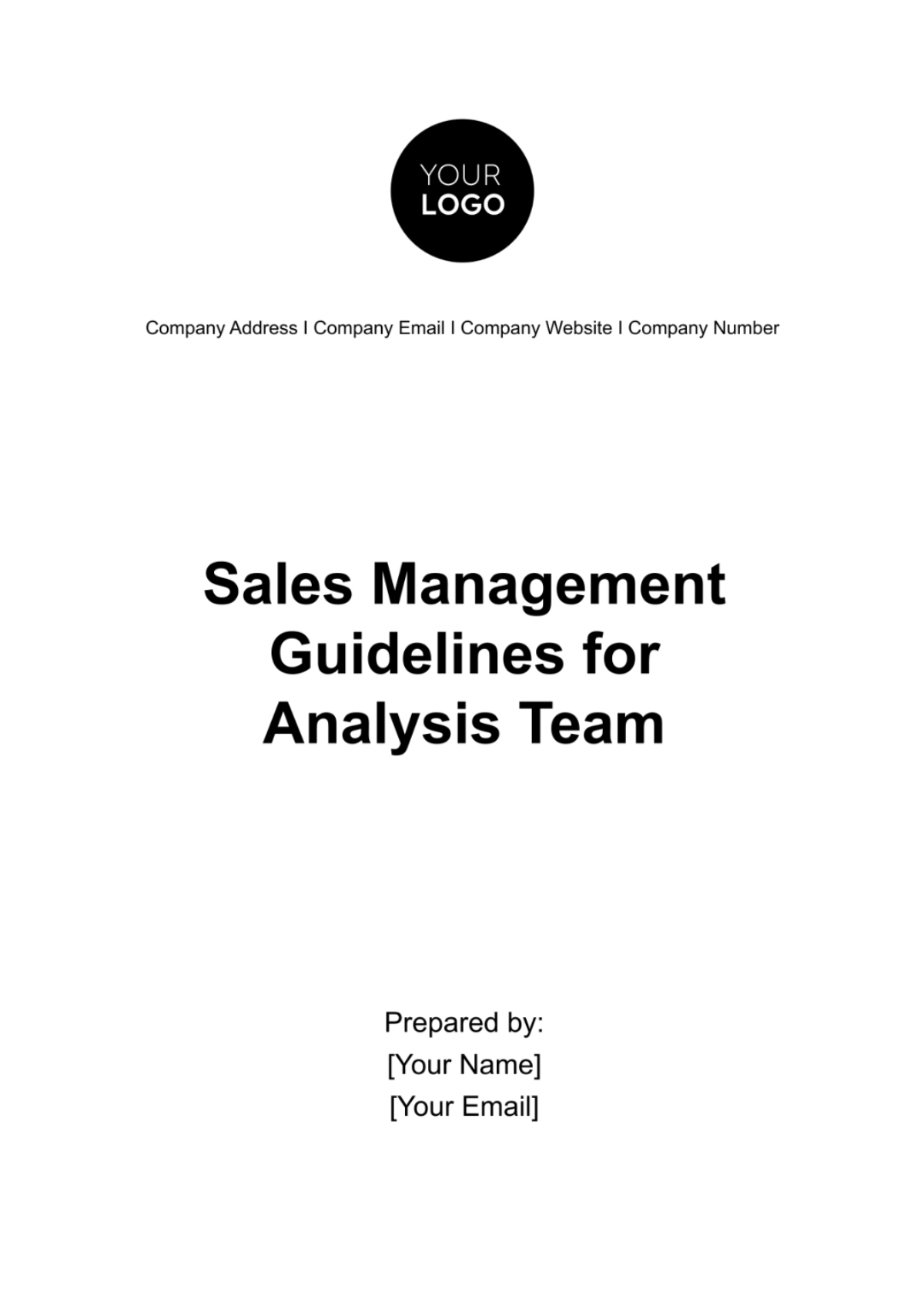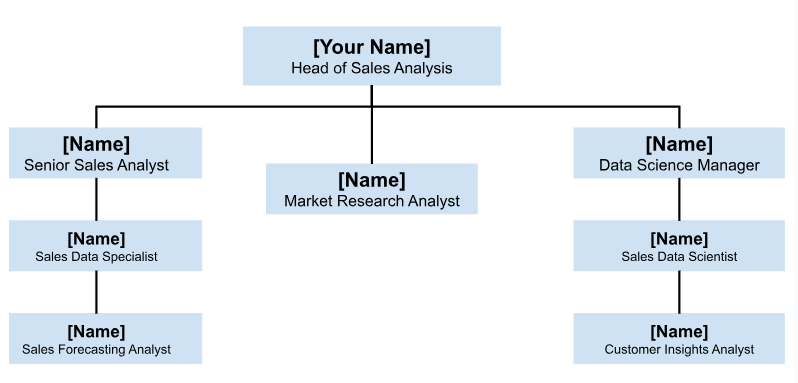Free Sales Management Guidelines for Analysis Team

Analysis Team
Introduction
In this guideline, we will cover the cutting-edge strategies, vital responsibilities, and industry-best practices essential for ensuring the remarkable success of our Analysis Team within the sales industry. The sales industry has undergone a profound transformation, marked by unprecedented technological advancements and shifting consumer behavior.
As a result, our Analysis Team's role has never been more important to our business operations. We stand on the forefront of a data-driven revolution, where insights hold the key to unlocking uncharted potential and driving unprecedented growth.
Sales Analysis Team Structure
The Analysis Team is a vital component of our sales department, ensuring that our sales strategies are data-driven and optimized for success. It comprises analysts and data scientists who work collaboratively to provide insights that empower our sales team. The team reports to [Your Name], Head of Sales Analysis.

Team Responsibilities
The Sales Analysis Team shoulders a range of pivotal responsibilities essential for steering our sales department toward success:
Data Harvesting and Precision Processing: The team diligently collects and expertly processes sales data. Their approach ensures the data's integrity and accuracy, forming the foundation for informed decision-making.
Market Insights and Competitive Edge: The team delves into the market's intricacies. They conduct comprehensive market research and perform in-depth competitor analysis, offering us a competitive advantage by deciphering industry dynamics.
Unlocking Sales Trends and Patterns: Our analysts oversee the sales trends and patterns. Their expertise in data analytics helps us identify subtle shifts and recurring behaviors, providing us with a roadmap for sustainable growth.
Futurecasting with Precision: By using the company’s historical data and advanced tools, the team develops forecasts and sales models. These forecasts help us anticipate market changes, adapt proactively, and allocate resources efficiently.
Insights that Drive Action: These insights are actionable intelligence that empowers our sales team to make decisions that matter. The Sales Analysis Team's contributions directly impact our ability to seize opportunities and overcome challenges in the ever-evolving sales landscape.
Data Collection and Analysis
The foundation of our Analysis Team's success lies in the efficient collection and analysis of data. We are committed to staying at the forefront of technological advancements, employing cutting-edge tools and technologies to gather, clean, and analyze sales data. Here's a deeper dive into this critical aspect:
Data Collection
Multi-Source Integration: Our data collection process involves integrating data from various sources, including online sales platforms, customer interactions, IoT devices, and more. This enables us to create a comprehensive dataset.
Real-Time Data Streams: We tap into real-time data streams. This allows us to monitor sales activities as they occur, enabling us to respond swiftly to changing market dynamics.
Data Enrichment: We employ data enrichment techniques, leveraging AI and machine learning algorithms to add valuable contextual information to our datasets. This helps us better understand customer behavior and preferences.
Data Analysis
Predictive Analytics: Our data analysts utilize advanced algorithms to forecast future sales trends. This not only helps in proactively meeting customer demands but also aids in inventory management and resource allocation.
Segmentation and Personalization: By segmenting customers based on their behaviors and preferences, we tailor our sales strategies promotions, and recommendations to enhance the customer experience.
Sales Funnel Optimization: Understanding where potential customers drop off in the sales funnel is crucial. Our team continuously analyzes the sales funnel, identifying bottlenecks and opportunities for improvement.
Data Integrity and Accuracy
Data Governance: Data integrity and accuracy are non-negotiable. We maintain a robust data governance framework that includes data validation, error detection, and strict adherence to data entry standards. This ensures that our insights are built on a solid foundation.
Quality Assurance: Regular audits and quality assurance checks are performed to maintain the highest data quality standards. Any anomalies or discrepancies are promptly addressed to prevent misinformed decisions.
Data Security: In a world where data privacy is paramount, we take every measure to secure customer data. Our team strictly follows data protection regulations and employs encryption and access controls to safeguard sensitive information.
Key Performance Indicators (KPIs)
Our Analysis Team operates within a structured framework of Key Performance Indicators (KPIs) that serve as compass points, guiding our pursuit of excellence. These KPIs include:
Sales Growth Trends: Tracking the trajectory of sales growth over time, this KPI offers vital insights into our market performance. It allows us to assess whether we are moving towards our revenue objectives and the factors influencing these trends.
Customer Segmentation: In a personalized sales landscape, understanding our diverse customer base is paramount. Our team monitors customer segmentation, enabling us to tailor marketing efforts and strategies to meet the unique needs of distinct customer groups.
Conversion Rates: Conversion is the heartbeat of sales. We scrutinize conversion rates to gauge the efficiency of our sales funnel. High conversion rates indicate optimal lead nurturing and sales tactics, while low rates may signal areas for improvement.
Sales Funnel Analysis: The sales funnel is our pathway to success. We dissect it, identifying bottlenecks and drop-off points, which aids in optimizing our sales process for maximum efficiency and effectiveness.
Customer Lifetime Value: Our customers are our most valuable assets. We measure customer lifetime value to understand the long-term impact of our relationship with customers.
Reporting and Presentation
The Analysis Team is responsible for generating regular reports and presentations that provide key insights and recommendations. These processes are calibrated to ensure that essential information is effectively communicated to both the sales team and senior management.
Report Generation: Ensure reports are logically organized, with sections dedicated to sales performance, market analysis, customer insights, and strategic recommendations. Focus on clear, concise language and data visualization techniques to enhance readability and comprehension.
Presentation Development: Utilize engaging visuals and narratives to maintain audience interest. Emphasize key points through storytelling and data visualization. Incorporate interactive elements such as Q&A sessions to foster engagement and facilitate deeper understanding.
Feedback Integration: Regularly solicit feedback on the usefulness and clarity of reports and presentations. Use this feedback to continually refine and improve future outputs. Implement a cycle of continuous improvement in reporting and presentation techniques, informed by stakeholder feedback.
Communication and Dissemination: Ensure effective distribution of reports and presentations to relevant stakeholders. Utilize appropriate communication channels, such as email, company intranet, or meetings, to disseminate information efficiently.
Training and Development: Implement training programs focused on advanced data analysis, report writing, and presentation skills. Regularly assess the performance of team members and provide opportunities for professional growth and development.
By following these strategies, the Analysis Team can significantly enhance their contribution to the sales management process, ensuring that their reports and presentations not only inform but also drive strategic decisions and actions.
Tools and Technology
This section provides an in-depth look at the tools and technology that our team will be using to excel in their data-driven roles.
Advanced Analytics Software: Our team leverages advanced analytics software that incorporates the latest in data processing and visualization. This software enables us to dive deep into the data system, extracting valuable trends, patterns, and anomalies that would be otherwise imperceptible. We continuously evaluate and invest in the most advanced analytics platforms to ensure our analyses remain at the forefront of the industry.
Machine Learning Algorithms: Machine learning algorithms are at the core of our predictive modeling and data interpretation. These algorithms allow us to identify and predict customer behavior, optimize pricing strategies, and streamline our sales processes. Our team constantly fine-tunes and updates these algorithms to adapt to changing market conditions, ensuring our forecasts are as accurate as possible.
AI-Driven Tools: AI-driven tools help automate data collection, pattern recognition, and even generate insights. These tools assist our analysts by handling repetitive tasks, allowing them to focus on more strategic and creative aspects of analysis. We consistently explore and integrate emerging AI technologies to enhance the team's efficiency and effectiveness.
Regular Software and Hardware Updates: Our IT department ensures that we are equipped with the latest software versions, as well as powerful hardware capable of handling large datasets and complex computations. This proactive approach guarantees that our team remains agile and adaptable, ready to embrace new technological advancements as they emerge.
Communication and Collaboration
Collaboration within the Analysis Team extends beyond our immediate department. It is imperative that our team collaborates with other departments to ensure the alignment of strategies and goals. Effective communication and collaboration are the cornerstones of our success.
By maintaining open channels of communication, our team can exchange insights and findings with Marketing, thereby creating a feedback loop that refines our strategies and optimizes our approach. This collaborative approach transcends departmental boundaries, creating a holistic view of our sales efforts. Additionally, shared dashboards will provide a transparent and accessible platform for real-time data sharing, ensuring that everyone is on the same page.
Conclusion
The Sales Management Guidelines for the Analysis Team summarizes a comprehensive framework designed to optimize the team's effectiveness in data collection, analysis, report generation, and presentation development. Through adherence to structured processes and continuous improvement, the team is empowered to produce insightful, actionable reports and engaging presentations that are integral to strategic decision-making. These guidelines will serve as a basis in elevating the sales management process of [Your Company Name], driving business growth, and ensuring sustained competitive advantage.
- 100% Customizable, free editor
- Access 1 Million+ Templates, photo’s & graphics
- Download or share as a template
- Click and replace photos, graphics, text, backgrounds
- Resize, crop, AI write & more
- Access advanced editor
Streamline your analysis team's operations with the Sales Management Guidelines for Analysis Team Template from Template.net. This editable and customizable template lays out clear, structured guidelines for managing your sales analysis team effectively. Fine-tune it using our AI Editor tool, ensuring optimal performance and strategic alignment in your sales management practices.





























